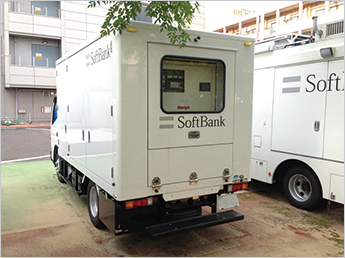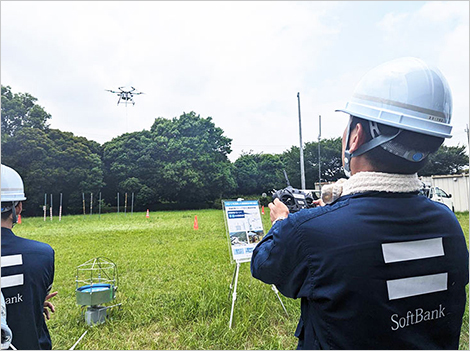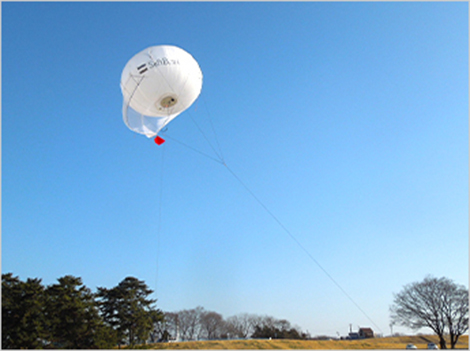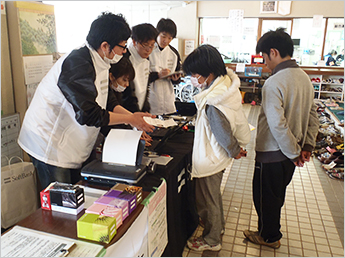Recovery Measures


Aspiring to bring hope to anxious people
When disaster strikes, we want to ensure the fastest possible recovery of communications facilities (lifelines),
and rapid support including initial assistance and the setting up of evacuation centers.
We want to create an environment in which disaster victims can have some peace of mind.
Mobile communications service initiatives
When disasters strike, mobile phones are an important lifeline that people use to get information and to check that their friends and family members are safe. We are planning a disaster-resistant communications network and are striving to create systems that can rapidly recover from a disaster.
Strengthening equipment against disasters
Our network centers have enhanced earthquake resistance, redundancy and are capable of continuous operation when there are power outages
SoftBank checks and reinforces earthquake resistance at all its base stations and has improved communications reliability by preparing backup routings for primary transmission channels. We are implementing measures at critical base stations that will extend operational time during a power outage from 48 to 72 hours.
Base stations that remain operational for more than 24 hours after a power outage
SoftBank is working to reinforce provisions for generators and batteries at base stations, to provide uninterrupted services even during power outages, especially at base stations located around areas containing key facilities that play critical roles in a disaster management, such as government agencies and hospitals.
Deploying mobile power supply vehicles across Japan
We have mobile power supply vehicles across Japan to provide power to base stations in the case of power outages in a disaster.

(As of June 2023)
| Number of mobile power supply vehicles by region | |||
|---|---|---|---|
| Hokkaido | 6 | Kinki | 11 |
| Tohoku | 9 | Chugoku | 6 |
| Kanto | 18 | Shikoku | 6 |
| Shinetsu | 3 | Kyushu | 13 |
| Hokuriku | 5 | Okinawa | 4 |
| Tokai | 10 | Total | 91 vehicles |
Securing communications when disaster strikes
Securing critical communications
In a major disaster, mobile phone and Internet access surges in the affected areas from customers trying to confirm the safety of their family and friends may result in difficulties with regular communications.
To prevent a large-scale network system failure caused by increased congestion, and protect emergency calls (the telephone numbers 110 and 119 in Japan) and other important communications, SoftBank may temporarily regulate communications services in accordance with the Telecommunications Business Act and in proportion to the scale of the congestion. Through such communications regulation, we are able to protect and preserve a degree of communications services while avoiding a major communications failure. We ask for our customers' understanding with regard to any inconveniences this may cause.

Restoring services
Development and implementation of wireless relay system by “wire-powered drones” and “tethered-balloons”
To quickly restore lifeline mobile phone service following a disaster, we are developing various disaster response solutions. The “Tethered Balloon Wireless Relay System” and “Wire-Powered Drone Wireless Relay System” have already been put into operation and are being deployed in key locations throughout Japan.
We aim to provide stable communication services and a quick restoration of service areas affected by natural disasters by using a “wire-powered drone wireless relay system” that can be constructed within 30 minutes of arrival and is ideal for short-term use, as well as a “tethered balloon wireless relay system” that is suitable for long-term use of one month or more. Our vision is to achieve a “connected society anytime, anywhere.”


Deployment of mobile base-station vehicles and portable base stations
SoftBank will deploy mobile base stations to rapidly restore services in disaster areas where base stations have been damaged or have lost power. There are many types of mobile base stations positioned across Japan for use in emergencies.
Mobile base station vehicles
|
Small 
|
Used to establish a temporary base station via satellite link-up when communication lines are damaged in a disaster. Small mobile base station vehicles use their mobility to quickly reach disaster areas. | |
|---|---|---|
| Coverage radius | Approx. 1.8 km | |
| Maximum number of phone lines | 13 | |
|
Medium 
|
Used to establish a temporary base station via satellite link-up and usable land-lines when communication lines are damaged in a disaster. | |
| Coverage radius | Approx. 1.8-5km | |
| Maximum number of phone lines | 200 | |
|
Large 
|
Used to establish a temporary base station via satellite link-up and usable land-lines when communication lines are damaged in a disaster. Large mobile base station vehicles are the highest capacity type, and all support SoftBank 4G LTE. | |
| Coverage radius | Approx. 5km | |
| Maximum number of phone lines | 700 | |
(As of June 2023)
| Number of mobile base station vehicles by region | |||
|---|---|---|---|
| Small | Medium | Large | |
| Hokkaido | 1 | 4 | 2 |
| Tohoku | 1 | 4 | 3 |
| Kanto | 3 | 13 | 11 |
| Shinetsu | 0 | 2 | 0 |
| Hokuriku | 1 | 2 | 2 |
| Tokai | 1 | 4 | 6 |
| Kinki | 1 | 6 | 4 |
| Chugoku | 1 | 4 | 2 |
| Shikoku | 0 | 3 | 2 |
| Kyushu | 1 | 7 | 3 |
| Okinawa | 0 | 5 | 1 |
| Total | 10 vehicles | 54 vehicles | 36 vehicles |
Portable mobile base stations

|
Two hundred ten satellite link-up-capable portable mobile base stations are positioned across Japan. One hundred of these have vehicle-mounting capability. | |
|---|---|---|
| Coverage radius | Approx. 1.8km | |
| Maximum number of phone lines | Approx. 13 | |
- [Notes]
-
- *
In areas with weak reception such as tunnels, buildings, underground and mountainous areas, service may not be available even within the coverage radius.
- *
Please note that there may also be interruptions to service even in cases where the signal strength indicators on mobile devices display maximum level.
- *
The maximum number of phone lines is dependent on the number of landlines that can be prepared in a disaster.
- *
High-speed satellite communication links
The satellite links used by our mobile base-station vehicles and our mobile base-stations can achieve communication download speeds of up to 100 Mbps and upload speeds of up to 10 Mbps, enabling functional communications.
Rapid restoration of service at damaged base stations
Creating new transmission routes at existing base stations
When damaged transmission lines render base stations inoperative, these base stations will be brought back into operation by establishing interexchange transmission routes using microwave relays, temporary dedicated lines, and equipment for satellite communications.

|
Mobile satellite antennas These are auto-acquiring satellite antennas that can be used to quickly set up temporary satellite-based communication links. We have deployed 282 of these antennas in Japan. (As of June 2023)
|
||||||||||||||||||||||||||||
|---|---|---|---|---|---|---|---|---|---|---|---|---|---|---|---|---|---|---|---|---|---|---|---|---|---|---|---|---|---|

|
Microwave relays Where there are no impediments to transmissions between base stations we will set up parabolic antennas that use microwave signals in place of damaged fiber optic lines. |
||||||||||||||||||||||||||||
Reconstruction of base stations
Should a base station become inoperable due to damage to the facility or communications equipment, it can be rebuilt in the same place after checking the safety of the ground and foundations and confirming that users are present to use the base station.
Providing means of communication
| Loan of mobile phones to local governments and others |

SoftBank has positioned 1,500 satellite and mobile phones at locations across Japan for use in relief and recovery activities in disaster areas, and has prepared a structure whereby they can be loaned free of charge to local governments, public organizations, NPOs and other organizations.
|
|---|---|
| Securing means of communication for disaster victims |

As part of our assistance to evacuation centers when a disaster strikes, we provide mobile phones, fixed-line phones, Wi-Fi equipment, and recharging facilities free of charge to ensure people have connectivity to confirm the safety of others and gather recovery-related information. |
Fixed-line communications service initiatives
To be able to offer reliable and high-quality fixed-line communications services and support during a disaster, we are upgrading our facilities and operational systems business continuity even in the case of unforeseen circumstances.
Strengthening equipment against disasters
As a communications operator, SoftBank is taking all possible disaster prevention measures to ensure that facilities containing communications equipment are built to be resilient against earthquakes, fires, power outages and other disasters.
| Disaster prevention measures | |
|---|---|
| Resilience measures |
Facilities are built to withstand an M 7-class earthquake.
|
| Provisions for power outages |
Two power sources are secured even during usual operation times, but in the event of an emergency and power outage, uninterruptible power sources (batteries) and emergency power generators can supply electricity for 48-72 hours. |
Securing communications
| Transmission line redundancy and multi-routing |
Fiber-optic cables and communication transmission line systems laid across Japan are designed and installed for redundancy so traffic can be rerouted in the case of an outage. This strong resilience to outages supports the networks of the SoftBank Group. |
|---|---|
| Distributed network centers |
Network centers are distributed throughout the regions of Japan, primarily in the major cities of |
Implementing BCP measures
In order to fulfill our responsibilities as a telecommunications carrier that manages infrastructure with respect to the expanding scale of disasters in recent years, we have established the objective of “building high-quality social infrastructure” within our material issues to enact measures to maintain telecommunications infrastructure during a disaster on a regular basis. We regularly conduct various types of training, such as “organization-wide holistic disaster response training” and “network failure response training” aimed at improving network maintenance and operation systems to prepare for large-scale disasters. By improving the challenges and issues revealed through training and continuing to conduct training, we are working towards building a more resilient BCP foundation.